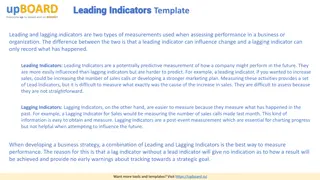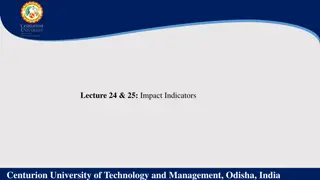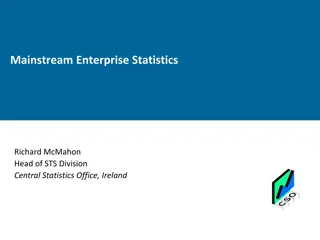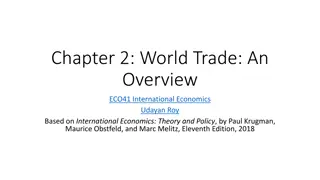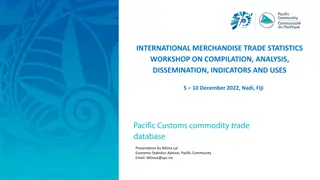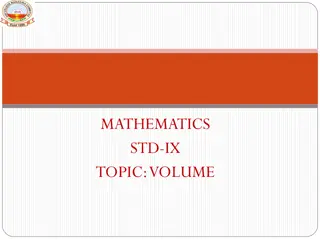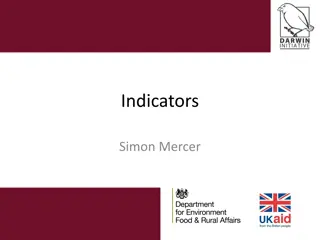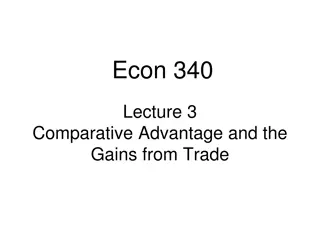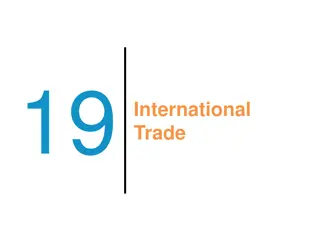Manual on Principal Indicators for Business and Trade Statistics - Volume 2
The United Nations Conference on Trade and Development has developed Volume 2 of the Manual on Principal Indicators for Business and Trade Statistics to meet policy needs and enhance the reading and analysis of international trade data. The manual aims to benefit statisticians, compilers, researchers, and study managers by providing insights into international trade statistics for competitiveness, trade openness, economic policy formation, and more.
Download Presentation

Please find below an Image/Link to download the presentation.
The content on the website is provided AS IS for your information and personal use only. It may not be sold, licensed, or shared on other websites without obtaining consent from the author. Download presentation by click this link. If you encounter any issues during the download, it is possible that the publisher has removed the file from their server.
E N D
Presentation Transcript
UNITED NATIONS CONFERENCE ON TRADE AND DEVELOPMENT Manual on Principal Indicators for Business and Trade Statistics (Goods and Services), Volume. 2 Sub Task Team v.18 of the Task Team on International Trade Statisics Onno Hoffmeister (UNCTAD/Statistics), Ouljour Houssaine (Office des Changes Morocco) 6th Meeting of the United Nations Committee on Business and Trade Statistics M rida (Mexico), 18-21 September 2023
Structure 1. Background and objectives 2. Content 3. Way forward 6th UNCEBTS Meeting Onno Hoffmeister, Ouljour Houssaine
Background and objectives UNCEBTS has identified the need to develop Volume 2 of the Manual on Principal Indicators for Business and Trade Statistics. Goals: Meet policy needs Easier and better reading of foreign trade data. Manual on Principal Indicators for Business and Trade Statistics, Vol. 1, White cover publication The indicators should be designed to enable better quality and analysis of international trade statistics. 6th UNCEBTS Meeting Onno Hoffmeister, Ouljour Houssaine
Target audience Statistics producers International trade statisticians Compilers of BoP, National Accounts, and other related statistics Statistics users Researchers Study managers in public administrations or private institutitions 6th UNCEBTS Meeting Onno Hoffmeister, Ouljour Houssaine
International trade statistics what for? Competitiveness and trade openness Measure countries performance Design effective and sustainable trade policy Level of diversificatio n of goods and services Integration on regional and bilateral trade flows Internationa l Trade Export specialization 6th UNCEBTS Meeting Onno Hoffmeister, Ouljour Houssaine
Purposes of international trade statistics Formation of economic policy Understanding a country s role in the global economy Assessing the degree of integration with the global economy Monitoring of external balances and correct imbalances Design of free trade agreements Projections Research in International Economics 6th UNCEBTS Meeting Onno Hoffmeister, Ouljour Houssaine
Socio-economic impacts of international trade 6th UNCEBTS Meeting Onno Hoffmeister, Ouljour Houssaine
Consideration of UNCEBTS priority areas Business dynamics, demography, and entrepreneurship Capacity building Globalization and digitalization Well-being and sustainability 6th UNCEBTS Meeting Onno Hoffmeister, Ouljour Houssaine
Structure 1. Introduction 2. Strategic view and data production frameworks 3. The principal indicators 4. Future agenda 6th UNCEBTS Meeting Onno Hoffmeister, Ouljour Houssaine
Principle indicators proposed so far Level of diversification/ concentration 1.Hirschman-Herfindahl Index 2.Export Diversification Index 3.Export Product Concentration Index 4.Import Product Concentration Index 5.Export Market Concentration Index 6.Import Market Concentration Index Global trade and trade openness Trade intensity and specialization 1.Trade balance 2.Foreign trade coverage ratio 3.Trade balance in goods and services as a percentage of GDP 4.Trade to GDP ratio 5.Export propensity 6.Import penetration ratio 7.Trade per capita 8.Trade share 9.Market Share 10.Terms of trade 1.Trade Intensity Index 2.Trade Complementarity Index 3.Intra-regionaltrade intensity Index 4.Intra-industry trade (Grubel-Lloyd Index) 5.Revealed Comparative Advantage (RCA) 6.Export Specialization Index 6th UNCEBTS Meeting Onno Hoffmeister, Ouljour Houssaine
Further discussions on indicators Use of the Theil index as a measure of export and import concentration (market and product) Integration of indicators from GN-h.4 (environment and sustainability) and GN-h.5 (wellbeing, labor, and productivity) 6th UNCEBTS Meeting Onno Hoffmeister, Ouljour Houssaine
Timeline Sep Oct 2023 Initial drafting (1st editing round) Sharing an initial draft with TT-ITS for discussion Revision of the text (2nd editing round) Sharing the revised draft with TT-ITS for discussion Sharing the document with UNCEBTS Bureau for endorsement Incorporation of feedback from UNCEBTS Preparation of the Global Consultation Global Consultation Final drafting Endorsement by the UNCEBTS Bureau Nov Dec 2023 Jan Feb 2024 Mar Apr 2024 May Jul 2024 Aug Nov 2024 6th UNCEBTS Meeting Onno Hoffmeister, Ouljour Houssaine




